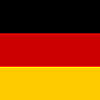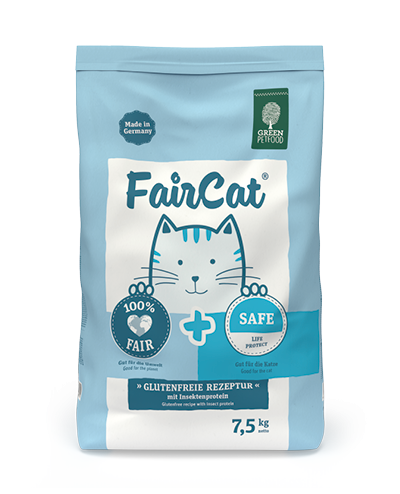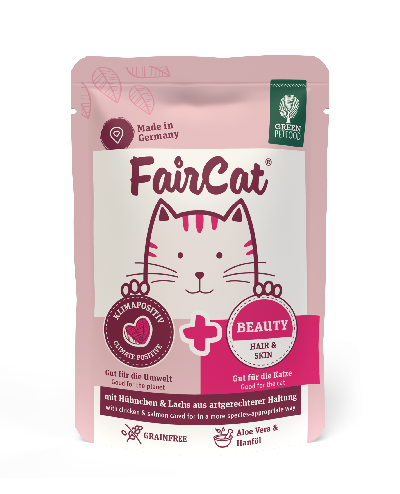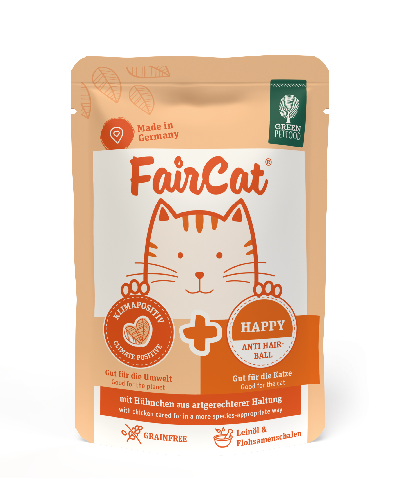The right cat diet
Fresh, wet or dry – what is the right cat diet? The right nutrition is the cornerstone for a long and healthy cat life. It varies from person to person whether a cat prefers to eat fresh, wet or dry food. Find out here what you should consider when feeding your floofy pet and whether there is THE one feed.
Feeding cats correctly
In general, it can be said that a cats diet should consist mainly of protein. About 20-35 % of the food should be protein (e.g. meat or fish) and 10-20 % fat. It is also important that vitamins, fibre and minerals are included.
Here is a list of what should be included in a good cat food:
- Protein: Proteins are made up of different amino acids. Cats need ten different amino acids. Cats can only poorly compensate for a deficiency. That's why it's also important that sick cats can eat again quickly, otherwise it can become life-threatening for them.
- Fats: Cats need certain unsaturated fatty acids that they cannot produce themselves. This means that these must be absorbed by it through food. Arachidonic acid, an important fatty acid needed, is found in heart, liver and poultry fat.
- Carbohydrates: Cats need relatively few carbohydrates and these few must already be broken down for cats to digest them. Rice and potatoes are particularly suitable.
- Vitamin A: Cats also only need vitamins in small quantities, but they are nevertheless indispensable for many metabolic processes. For example, cats cannot convert vitamin A from the beta-carotene contained in carrots. Cats are not capable of this synthesis step, they must absorb the vitamin A directly. It is found in animal tissues, especially liver and fish oils.
- Taurine: Taurine is a breakdown product of certain amino acids. It cannot be synthesised by cats themselves and must therefore be ingested with food such as meat or fish. A lack of taurine, as would happen, for example, through feeding a cat with dog foods can lead to blindness.
- Calcium: Cats also need calcium to build up their bones and must take it in through their food. Calcium is found in bones or cartilage.
- Phosphorus: Phosphorus is also important for healthy bones. However, too much phosphorus is harmful to a cat's kidneys. Especially for cats with kidney disease, it is therefore important to ensure a low phosphorus content in the diet. Meat contains a lot of phosphorus and little calcium, whereas bones contain a lot of calcium and little phosphorus.
The right amount of food
The right amount of pets food depends on your cat's basal metabolic rate. Young and active cats need more cat food than older cats. With kittens, you don't need to worry about them getting fat. They have an extremely good metabolism and can therefore eat a little more.
Large male cats need more food than small cats. On canned food it often says that a normal domestic cat needs about 150-200 g of food per day. Of course, these are only average figures, but you can still use them as a guide.
If you can no longer feel your cat's ribs, you should slowly reduce the amount of food.
Difference between dry food, wet food and BARF
- Dry food: Dry food has a long shelf life and is easy to portion. The dried and pressed pellets contain various ingredients that are vital for cats. In addition, there are different varieties that are adapted to specific needs such as old age, renal insufficiency or diet.
- Wet food: Wet food usually consists of meat or fish and various vegetables. It is available with more or less sauce, as jelly or paté. These are usually packaged in tins, sachets or trays.
- BARF: If you want to barf your cat, you have to prepare the food yourself from raw meat, vegetables, vitamins and minerals. An optimal balance is very important so that your cat is supplied with all vital nutrients that we mentoned above.
Note
Mixed feeding of all three or even just two is also perfectly fine. A mix is also a species-appropriate and balanced cat diet.
It is important that you make sure that your cat drinks enough fluids. Especially if you use dry food. This has a low water content, which is why the cat always needs enough fresh water.
In nature, the four-legged friends usually cover their fluid requirements only through food. They therefore usually drink very little. This means that with a purely dry diet, care must always be taken to ensure that the cat is sufficiently hydrated. If they do not take in enough fluid, they do not die of thirst, but bladder and kidney stones can form and the kidneys can suffer.
Can I barf my cat?
It is of course possible to BARF (bones and raw food) a cat, because in the wild it eats mainly raw meat, such as mice, birds or even insects.
So if you want to feed fresh food, the food should consist of raw meat, vegetables and supplements such as vitamins and minerals. Optimal coordination is important to ensure that the cat is supplied with all vital nutrients.
In barfing, the main ingredient is meat. The larger proportion is muscle meat (e.g. head meat, hearts, breast meat). However, offal such as liver, kidney, lung or rumen/poultry stomachs are also suitable. 1/3 of the meat should be fleshy bones in the form of wings, necks. If your cat cannot digest this amount, you can also resort to calcium in powder form such as eggshell powder or algae lime.
Add raw, pureed vegetables and fruit to the meat. Vegetables such as parsnip, carrot, courgette, cucumber are best suited here. The vegetables can simply be mixed with the meat.
If your cat is only indoors and cannot hunt for itself, you can also buy and feed mice and day-old chicks.
Taurine and BARF
In nature, cats meet their taurine needs with the help of their captured prey, because fresh blood is one of the best sources of taurine. But hearts are also rich in taurine. For example, you can feed chicken hearts raw several times a week.
But tuna, lamb or beef also contain taurine.
Green-lipped mussel powder can also be used as a food supplement, as it has a high natural taurine content. Simply mix into the meat in the specified quantity.
In nature, cats catch 6-12 mice per day. On average, every cat consumes about 70 mg of taurine per day. To prevent a deficiency, a food supplement with taurine is definitely a good idea if you decide to feed your cat.
What ist the right nutrition for kittens?
Baby cats need certain nutrients for optimal development. Here, too, a high protein content is important. Growing cats have a high energy requirement as they run around and play a lot. Kitten food should contain calcium, magnesium and phosphorus because these are particularly important for the bones and muscles. Therefore, always look for cat food, whether wet or dry food, that is adapted to the needs of the kitten.
What diet is right for old cats?
When your cat is older or old, it needs a food that has a reduced energy content. As cats get older, they move less and therefore need different food than kittens.
Old cats also need special ingredients that stimulate the metabolism and slow down cell ageing.
What to do in case of feed intolerance?
Some cats are allergic to certain food ingredients or cannot digest them well. It can cause digestive disorders and fur and skin problems. In many cases, cereals and animal proteins are responsible for this. Grain-free or hypoallergenic cat food does not contain these typical allergens and thus offers sensitive cats optimal cat nutrition.
We offer light food for cats, both as wet and dry food. You can find these in our cat food range with a detailed description of the ingredients. Our food contains only high-quality ingredients that are low in allergens, gentle on the stomach and contain only one or two protein sources. All foods are also generally suitable for cats with a sensitive stomach.
What is the right diet for renal failure in cats?
Kidney disease is common in cats and affects about one in three cats over the age of 10. It is therefore even more important that you use a high-quality food, as this can prevent kidney failure.
However, when this disease occurs, your cat needs special food, which also contains less energy, i.e. also less protein, because the kidneys no longer work as well as they did in younger years. A special food for renal insufficiency relieves the cat's organs and supports them in their function.
Not all meat is the same
Often cat food consists of cheap meat, just because it claims to have a high meat content, the composition does not automatically consist of healthy meat.
The declaration "meat and animal by-products" are animal by-products and these are mostly offal.
The same applies to the "vegetable by-products". These are often cereal hulls or husks that are difficult to digest. It is important that the pure meat content is marked on the feed cans and that cereals and sugar are not included at all.
What meat should be included in cat food?
Poultry, beef, venison or duck. Almost any meat can be used as food for a cat. The meat can be fed fresh either in the form of high-quality wet or dry food or in its raw state. This is possible with all types of meat except pork because this can transmit the Aujeszky virus, which is a pathogen for pseudorabies. This disease can be fatal for cats. In addition, pork is often very fatty and therefore not advisable if your kitty weighs a little more. If your pet doesn't exercise much or is already older, lean meat from beef or poultry is good.
Besides muscle meat, offal such as heart, liver and stomach are also suitable, but of course fish as well. Salmon is particularly good because it has a high proportion of valuable omega-3 and omega-6 fatty acids.
What else should a cat diet contain besides meat?
The cat food should have a high meat content, but also vegetable ingredients.
The meat provides your pet with important proteins as well as nutrients such as vitamins and minerals contained therein. The plant components also serve to optimally cover the need for energy as well as nutrients.
High-quality cat foods with a high meat content are therefore provided with carbohydrate sources, vegetables and other ingredients. If you pay attention to a balanced composition of ingredients in cat food with a high meat content, you can prevent deficiency symptoms in your cat.
Cat food should not contain grain – is that correct?
Not all grains are the same. While wheat in cat food is not exactly beneficial, other grains, such as rice, are very tolerable and also suitable for sensitive kittens. Basically, cats hardly need any carbohydrates for a species-appropriate and natural diet. Vegetable carbohydrates are still important, but only certain ones. Because there are also gluten intolerances in cats. Gluten protein is found in wheat, rye, barley and spelt, among others.
The intolerance usually manifests itself in abdominal pain, loss of appetite and chronic diarrhoea. The symptoms are caused by the lack of an enzyme in the digestive tract that is actually responsible for breaking down the gluten. Since this is not possible, a permanent inflammation of the mucous membrane of the small intestine occurs.
A grain-free cat diet is recommended because it avoids wheat, rye and other grains and replaces them with sensible alternatives such as potatoes. It is also important that genetically modified ingredients such as soy or maize are also not included in the food because these are known to trigger allergies.
Characteristic symptoms of an allergy in cats:
- Frequent scratching
- Inflammation of the skin
- Excessive fur loss
- Digestive disorders
- Compulsive cleaning
- Conspicuous breathing
Can cheap cat food still be good?
We believe that cheap cat food is not really good for the health of your cat. You can't expect a can of wet food that only costs a few cents to be the best quality. Finding really good cat food is difficult and it is also more expensive than canned food with cheap meat because of the high-quality food-grade meat used. For the well-being of your cat, it is better to buy a somewhat expensive food, but you do not have to feed as much, as high-quality food naturally contains more nutrients. Since the nutrient content is much higher, you also need to feed less than the usual amount of cheap food. And that reduces the "higher" price by up to half. Also, as cats get older, there may be lower vet costs because they stay healthier in the longer term with a healthy high-quality diet.
What should not be included in cat food
- Animal by-products: Consist mostly of udders, hooves, feathers, bones, connective tissue, etc. These are low-quality slaughter waste that have almost no nutritional value.
- Fish by-products: Consists mostly of cheap fish waste.
- Artificial additives & flavour enhancers: Artificial additives and flavour enhancers have no place in cat food.
- Sugar: Sugar is harmful to cats and can lead to disease. Sugar is mostly used to mask bad smells of the offal and give it an appetising colour. Cooked fish or meat is grey and smells very strong, but if you add sugar, the food looks "nicer" and smells more pleasant - at least for humans.
We focus on high-quality and sustainable cat food
At Green Petfood, nutritionists and animal experts work purposefully on new products and product concepts. This is why we are able to combine scientific knowledge with innovation and sustainability to develop high-quality cat food (and dog food too) with exceptional recipes.
For us, sustainability means leaving the smallest carbon footprint possible. In line with this, we pay special attention to climate-friendly ingredients when selecting our raw materials. By using alternative protein sources and regional suppliers, we avoid a large amount of CO2 already in the composition of our recipes. We are constantly optimising our production process and are able to produce in a climate-friendly way with our energy management.
You want to know more about the quality of our products and how we offset CO2? Then read on here.
FairCat - Wet Cat Food
Our lean, completely grain-free wet food recipes contain only the best, preferably regional super premium ingredients. We only use chicken and salmon from species-appropriate husbandry and insects as a high-quality and sustainable source of protein. Combined with hemp oil, psyllium husks or green tea, our FairCat food will get your cat through all nine lives perfectly. These products are - of course - developed without the use of animal testing, and are produced without genetically-modified ingredients.
As a complete food, each variety contains all the nutrients your feline needs to feel like the cat that got the cream. But as our little gourmands don't like to find the same food in their bowl every day, you can combine our two dry food varieties and six wet food varieties perfectly, allowing you to conjure up a new menu for your feline friend every day. Everyone will find what they are looking for in our FairCat wet food - even cats with intolerances. With FairCat, you are purchasing a tried-and-tested quality product that has been produced in Germany.
No matter which of our cat foods you choose - it's good for your cat and the environment.




















